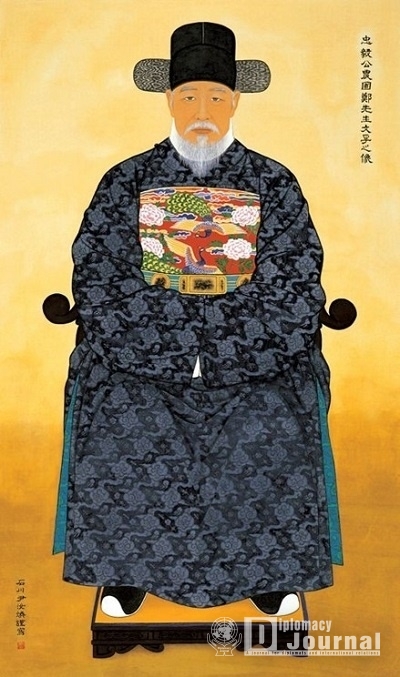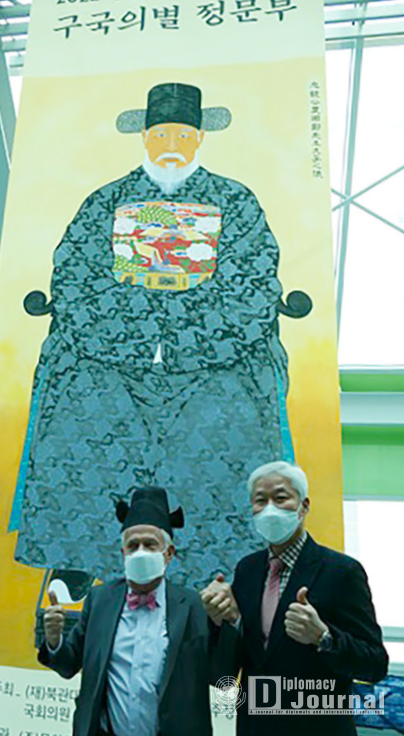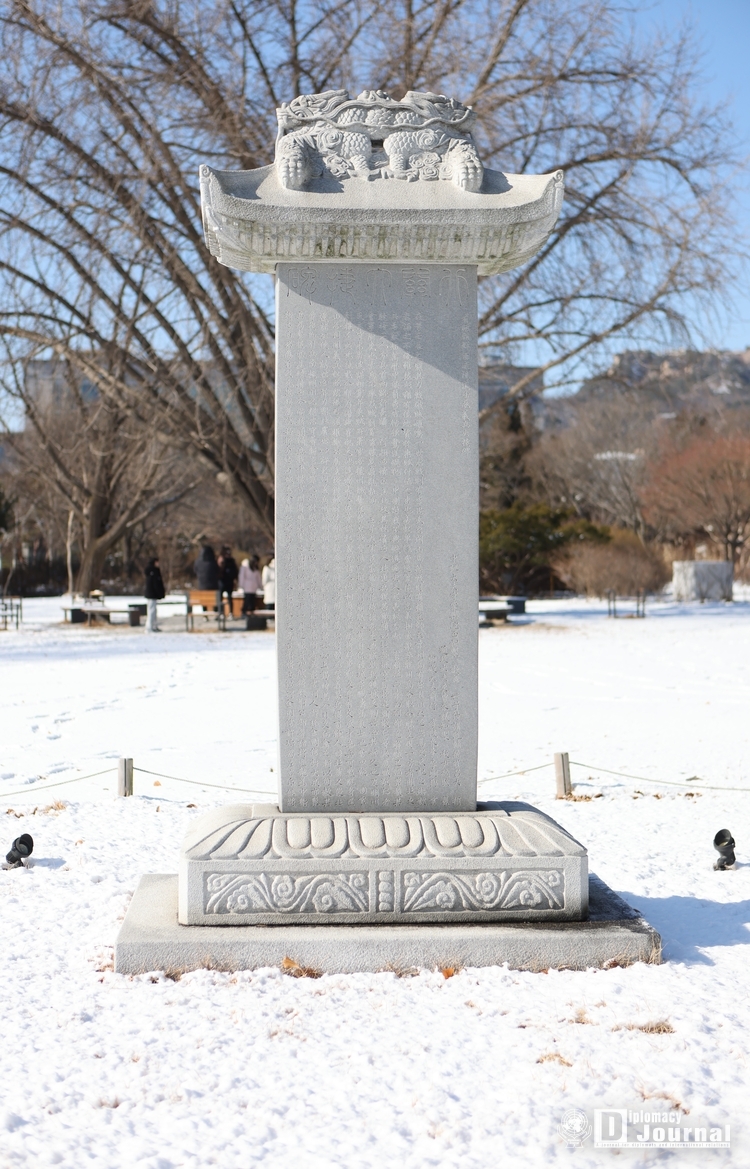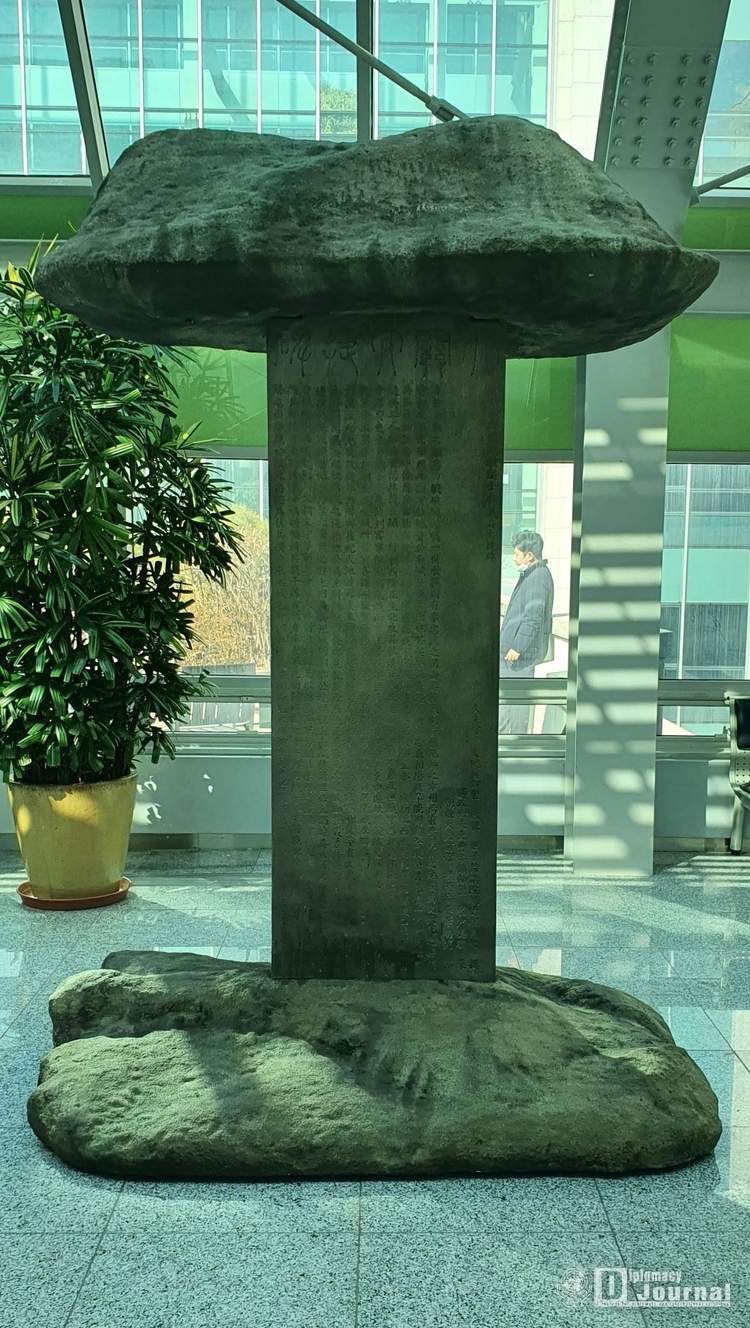By Lee Jon-young
Chairman Lee Jon-young of the Bukgwan Victory Monument (Bukgwandaecheopbi) National Movement Central Committee (Star who saved the country, General Jeong Mun-bu) will exhibit the stele for the victory in battle at the northern frontier by General Jeong Mun-bu from January 24, 2024, in the first-floor lobby of Doosan We’ve Building located at 81 Sambong-ro, Jongno-gu, Seoul.
The stele reproduces the 420-year history of the Bukgwan Victory Monument, which was looted by the Japanese in 1592 during the Imjin War, and returned to its hometown in North Korea after 100 years.

Jeong Mun-bu is considered one of the greatest land warriors of all time, having killed around 10,000 Japanese soldiers in the Battle of Bukgwan. In North Korea, he is also considered one of the two greatest generals of the Imjin War along with General Yi Sun-sin.
He is the only government official to be elected by the people to the position of chief of volunteer soldiers during the Imjin War. He was also the main character in the tragedy of his death, when he was falsely accused and tortured by treacherous retainers.
Former Chungbuk National Police Chief Jeong Yong-geun, a descendant of Haeju Jeong, said he hopes the spirit of General Jeong Mun-bu, the star who saved the country, and Bukwan Victory Monument, the soul of the people, will be widely known to the public through this exhibition.

Jeong Yong-geun, the former chief of the Chungbuk National Police, has applied for honorary retirement and registered as a People's Power Party’s candidate to run in Chungju in the upcoming general election.
Jeong, who has worked at the Blue House during the previous Lee Myung-bak and Park Geun-hye administrations, said he wants to do big things like his grandfather, General Jeong Mun-bu, the star who saved the country, in the current government if he is elected in this general election. He also expressed his intention to put down all vested interests and work only for the people if elected as a member of the National Assembly.

Jim Rogers, one of the world's top three investors, and Chairman Lee Jon-young visited the People's Power Party to meet with Yoon Suk-yeol when he was a presidential candidate. Jim Rogers, who toured the photo exhibition of General Jeong Mun-bu at the National Assembly, said, "I admire General Jeong Mun-bu. I want to be a General Rogers who brings North and South Korea together like General Chung," and said, "I am confident that this photo exhibition will be the beginning of the restoration of relations between North and South Korea."
The Bukgwan Victory Monument was returned to Korea from Japan in 2005. It was the Bukgwandaecheopbi, which had been stored at Yasukuni Shrine in Japan.
It was stolen by the Japanese in 1905 during the Russo-Japanese War, and was erected in Gilju, Hamgyong Province in the 34th year of King Sukjong (1707) to commemorate the defeat of the Japanese army led by Kiyomasa Kato in 1592, the first year of the Imjin War. Bukgwandaecheopbi means a monument commemorating a great victory in a war fought at Bukgwan, and Bukgwan refers to Hamgyongdo province.

During the Imjin War, the Japanese army, led by Kiyomasa, marched northward with devastating momentum and reached Hamhung. At the time, the Joseon government troops fled, but Jeong Mun-bu rallied the volunteer troops and repelled them.
Afterwards, Jeong Mun-bu was unable to fulfill his royal duties because he was ill when the rebellion of Yi Gwal occurred immediately after the Injo Rebellion, and he was repeatedly impeached and died in prison at the age of 60 on November 9, 1624, in the second year of King Injo.
Then, 41 years later, in the 6th year of King Hyunjong (1665), his identity was restored thanks to the appeal of the then Prime Minister Jeong Tae-hwa, and on this basis, in the 40th year of King Sukjong (1713), he received the title of Chung Eui-gong. The stele, which measures 187 centimeters high and 66 centimeters wide, details the exploits of the soldiers led by Jeong Mun-bu in about 1,500 characters.

But in 1905, the Japanese weren't having any of it. Major General Masisuke Ikeda, the commander of the 17th Brigade of the Japanese Army's 2nd Division stationed in the area at the time, stole the monument to Japan and left it for 100 years with a one-ton stone on top of its head. It is said that this is a hidden intention to hide their humiliating defeat.
Later, Cho So-ang, who traveled to Japan as an international student, discovered the Bukgwandaecheopbi at Yasukuni Shrine. "Who would not be indignant at this fact," he wrote in the Daehan Heung Hakbo, "and who would not be guilty of the great sin (of taking away the Bukgwandaecheopbi)?" He appealed.
However, this was a time when the sovereignty of the Korean Empire was gradually being usurped by Japan. In an article on June 19, 1926, in the Donga Ilbo, an anonymous contributor, known only as Lee Saeng, briefly recounted the news of the Bukgwandaecheopbi and testified that there was a wooden plaque standing next to it that read, "It is completely different from the facts at that time, so the world should not believe this inscription".

Amidst the chaos of liberation and the Korean War, the monument seemed to be gradually forgotten. It was not until 1978 that the monument was rediscovered.
It was found by Choi Seo-myeon, president of the International Institute of Korean Studies in Tokyo, who was neglected in a forest near Yasukuni Shrine. He researched ancient documents and discovered that the monument was forcibly brought to Japan in 1905 by Major General Masisuke Ikeda, the brigade commander of the Japanese Army's 2nd Reserve Division, which entered Hamgyong Province during the Russo-Japanese War.
The South Korean government was informed of the fact, and then-President Park Chung-hee personally intervened, but the Japanese refused to return it, saying that they could not freely hand over something that was originally on North Korean soil to South Korea.
After more than 20 years of neglect, the return of the monument was pushed by Monk Senshin Kakinuma, head of the Tiantai Buddhism sect, Japan's largest Buddhist sect, and chairman of the Japan-Korea Buddhist Welfare Association, who met with the late Emperor Igu in Japan in June 1997 to formally request the return of the monument to Yasukuni Shrine.
However, when that failed, Monk Kakinuma, the Japanese president of the Japan-Korea Buddhist Welfare Association, and Monk Chosan Eom Tae-jong, the Korean president of the Korea-Japan Buddhist Welfare Association, founded the same corporation in 1999 together and they began to appeal to the international community, including the United Nations.
In July 2004, Monk Kakinuma said, "If the Korean government does not take action this time, I will not continue to campaign for the return of the stele even after I return to Japan." In response, the Korean Embassy and many private organizations, including the Cultural Heritage Administration, began to gather strength to return the stele.
Monk Kakinuma and Monk Chosan then met with Yasukuni Shrine's Toshiaki Nanbu and agreed in principle to the early return of the monument, and the governments of both countries stepped in to negotiate the return.
On March 1, 2006, it was agreed that it would be handed over in Gaesong, and on March 23, it was reinstalled in its original place. The monument was then designated as National Treasure No. 193 of the Democratic People's Republic of Korea.
Jeong Mun-bu, the protagonist of the Bukgwandaecheopbi, was originally a civil servant, and at the age of 24, he was promoted to the rank of deputy in the department of literature, and at the age of 27, he was appointed as an assessor of chariots of war in North Hamgyong Province. A year later, the Imjin War broke out, and although he was only 28 years old, and there were others in higher positions, he was thrown into the fray and became the chief of civilian soldiers.
Although he was inexperienced in combat, he pacified Yeojin and Malgal in the north to strengthen the border, and in the south, he suppressed the rebellions in Hoeryeong, Gyeongseong, Myeongcheon, and other places to stabilize the rebellion. He then fought a bloody war for over four months against about 20,000 Japanese invaders who had occupied Hamgyong Province and drove them out of Hamgyong Province.
Designated as North Korea's national treasure cultural relic No. 193, it was erected in Gilju County, North Korea, in the 34th year of King Sukjong (1707) to commemorate the defeat of the Japanese army by General Jeong Mun-bu, but was looted by the Japanese during the Russo-Japanese War in 1905 and left at Yasukuni Shrine, a symbol of Japanese militarism.
It is inscribed with 1500 characters, including a record of how the volunteer soldiers of Hamgyeong Province repelled the Japanese during the Imjin War. The stele is 187 centimeters high, 66 centimeters wide, and 13 centimeters thick.
The Bukgwandaecheopbi repatriation schedule
2003 Negotiated the return with Monk Chosan and Monk Kakinuma Senshin of Japan-Korea Buddhist Welfare Association.
2005 Korea-Japan Buddhist Welfare Association (reestablished) under Damwha Lee Jon-young, chairman of the Beopwangcheong Peace Foundation
The first chairman of the board of directors, Monk Chosan Eom Tae-jong
May 28, 2005 Signed the North-South Agreement at the Pyongyang Pavilion in Beijing, China
Shim Sang-jin, Vice Chairman of the Central Committee of the Joseon Buddhist Federation Central Committee
Monk Chosan, President of the Korea-Japan Buddhist Welfare Association
Won Min-sik, Chairman of the Bukgwandaecheopbi National Movement Central Committee
Oct. 12, 2005 Korea and Japan signed the handover document of the Bukgwandaecheopbi
October 20, 2005 The Bukgwandaecheopbi was returned to Korea
February 13, 2006 Inter-Korean agreement for return it to North Korea signed
Shim Sang-jin, Vice Chairman of the Central Committee of the Joseon Buddhist Federation Central Committee
Monk Chosan, President of the Korea-Japan Buddhist Welfare Association
Won Min-sik, Chairman of the Bukgwandaecheopbi National Movement Central Committee
March 1, 2006 Handover ceremony at Seonggyeon Hall in Gaesong, North Korea
March 23, 2006 the Bukgwandaecheopbi was returned to its original location after many years.
Replicas now stand at the National Palace Museum, Independence Hall, General Jeong Mun-bu graveyard in Uijeongbu, and Gaho Seowon in Jinju.
The Bukgwandaecheopbi National Movement Central Committee plans to make a movie about the achievements of General Jeong Mun-bu, the star who saved the country.
The Bukgwandaecheopbi National Movement Central Committee
General Chairman Chosan Eom Tae-jong
Standing Chairman Won Min-sik
Chairman Damwha Lee Jon-young





